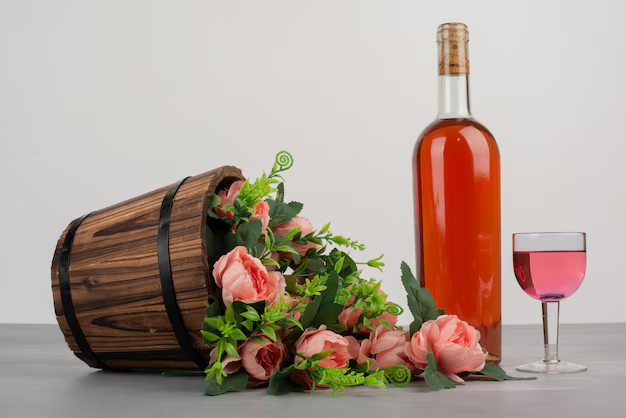Introduction to Rosè Wine
Rosè wine has skyrocketed in popularity in recent years. Known for its vibrant hues and refreshing taste, it’s a perfect wine for casual sipping, celebratory occasions, and pairing with a wide variety of dishes. But what exactly is rosè? How does it differ from red or white wine? And why has it become a global favorite?
In this comprehensive guide, we’ll explore the origins of rosè, how it’s made, the best types of rosè, its food pairings, and everything in between. Whether you’re a wine enthusiast or someone just beginning to explore the world of wine, this article will provide the insights you need.
What is Rosè Wine?
Rosè wine is a type of wine that combines characteristics of both red and white wines. Unlike red wines, which are made by fermenting the juice with the skins of dark-colored grapes, rosè wine is made by allowing the grape skins to remain in contact with the juice for a short period (typically between two to twenty hours). This process, known as “skin contact,” imparts a pink or light red color to the wine.
The flavor profile of rosè can vary depending on the grape variety, region of production, and winemaking process. However, ros’è is typically lighter and fruitier than red wine, with less tannin and acidity, making it an approachable option for new wine drinkers and seasoned connoisseurs alike.
The Making of Rosè Wine
The process of making rosè wine involves several important steps that differentiate it from other types of wine. Here’s a step-by-step look at how rosè wine is made:
-
Grape Harvesting: Like red and white wines, rosè starts with grapes. However, ros’è wines are typically made with red grape varieties, although there are some exceptions.
-
Skin Contact: After harvesting, the grapes are crushed, and the juice is left in contact with the grape skins for a short period of time. This period of maceration is critical to extracting the color and subtle tannins from the skins. The longer the skin contact, the deeper the color of the ros’è.
-
Pressing: Once the desired color is achieved, the juice is pressed off the skins. The pressing process also helps separate the juice from the pulp and skins.
-
Fermentation: After pressing, the juice is fermented in tanks or barrels. During fermentation, the sugars in the juice are converted into alcohol. Rosè wines are typically fermented at cooler temperatures to preserve their fresh, fruity flavors.
-
Aging and Bottling: After fermentation, ros’è wines are aged for a short period before being bottled. The aging process is usually brief, as rosè is meant to be consumed while it’s young and fresh.
Types of Rosè Wine
There are many different styles of rosè wine, each offering unique flavors, aromas, and colors. Some of the most popular types include:
-
Provence Rosè: One of the most well-known ros’è styles, Provence ros’è hails from the Provence region of France. Known for its pale, almost blush-colored hue, Provence rosè is crisp, dry, and light, with flavors of citrus, strawberries, and herbs. This style of rosè is often regarded as the epitome of elegance and sophistication.
-
White Zinfandel: Perhaps the most famous American ros’è, white zinfandel originates in California. It’s often sweeter than other rosès, with notes of melon, strawberry, and sometimes a hint of sweetness. White Zinfandel is a great option for those who prefer a slightly sweeter style of rosè.
-
Spanish Rosado: Rosé wines from Spain are called “rosado.” They vary in sweetness, but they are generally fuller-bodied than French or Italian rosès. A classic Spanish rosado might be made from Tempranillo or Garnacha grapes, and the wines can be fruity, with flavors of ripe berries, cherries, and sometimes spice.
-
Italian Rosato: Rosato is Italy’s version of ros’è wine. Italian rosatos vary widely in style, but they are often vibrant and bold, with fruit-forward flavors and higher acidity. Popular Italian rosato varieties include those made from Sangiovese or Pinot Grigio.
-
Rosè Champagne: For those who want to add a little sparkle to their ros’è experience, ros’è champagne is an excellent choice. These sparkling wines are made by adding a small amount of red wine to the base white wine, resulting in a unique, effervescent ros’è with delicate bubbles and a richer mouthfeel.
Rosè Wine Comparison Chart
To help you better understand the different styles of rosè wine, here’s a comparison chart:
| Type of Rosè | Origin | Taste Profile | Color | Ideal Pairing |
|---|---|---|---|---|
| Provence Rosè | France (Provence) | Crisp, dry, citrusy, herbal | Pale pink to light salmon | Seafood, salad, grilled chicken |
| White Zinfandel | USA (California) | Sweet, fruity, melon, strawberry | Pale pink | Spicy dishes, turkey, cheese |
| Spanish Rosado | Spain (various regions) | Fruity, full-bodied, ripe berries | Light to deep pink | Tapas, grilled meats, pasta |
| Italian Rosato | Italy (various regions) | Fresh, vibrant, bold, berry-rich | Light to medium pink | Pizza, antipasti, seafood |
| Rosè Champagne | France (Champagne region) | Elegant, effervescent, light red fruits | Rosy pink | Caviar, hors d’oeuvres, celebrations |
Best Food Pairings with Rosè Wine
One of the best things about ros’è wine is its versatility when it comes to food pairing. Thanks to its balance of fruitiness and acidity, rosè pairs well with a wide variety of dishes, from light appetizers to more substantial meals. Here are some top food pairings for different types of ros’è:
-
Provence Rosè: The crisp, dry nature of Provence ros’è makes it an excellent companion to seafood dishes, such as shrimp, oysters, and grilled fish. It also pairs beautifully with light salads, goat cheese, and grilled chicken.
-
White Zinfandel: The slightly sweeter profile of white zinfandel makes it an ideal match for spicy dishes, such as barbecue, spicy Asian food, or Mexican cuisine. It also complements turkey and cheese platters, making it a great choice for holiday meals.
-
Spanish Rosado: Spanish rosado’s fuller body and fruity flavors make it a great match for heartier foods, including grilled meats, paella, or pasta with tomato-based sauces. It also pairs nicely with tapas, such as chorizo or patatas bravas.
-
Italian Rosato: Italian rosato wines are perfect for pairing with classic Italian dishes, including pizza, pasta with pesto, and antipasti. They also go well with seafood and fresh salads.
-
Rosè Champagne: The effervescence of rosè champagne makes it a fantastic match for elegant dishes like caviar, smoked salmon, and hors d’oeuvres. It’s also a wonderful wine to serve at celebrations or with desserts like chocolate-covered strawberries.
Health Benefits of Rosè Wine
Like other types of wine, ros’è can offer some health benefits when consumed in moderation. Some of the potential benefits of drinking rosè wine include:
-
Rich in Antioxidants: Rosè wine contains antioxidants, such as resveratrol and flavonoids, which are found in the skins of grapes. These antioxidants have been linked to reduced inflammation and a lower risk of chronic diseases, including heart disease.
-
Improved Heart Health: Studies suggest that moderate consumption of ros’è, like other red wines, may support cardiovascular health by improving blood circulation and reducing blood pressure. The polyphenols in ros’è can help protect blood vessels and reduce the risk of heart disease.
-
Promotes Digestion: Rosè wine can help stimulate the digestive system, promoting healthy digestion and reducing bloating. Its acidity can also aid in the breakdown of food, especially fatty or protein-rich dishes.
-
Mood Boosting: Drinking ros’è in a social setting can help improve your mood and promote relaxation. The presence of alcohol in rosè wine has a calming effect on the nervous system, which may help reduce stress and anxiety.
Conclusion
Rosè wine continues to rise in popularity due to its refreshing, versatile nature and broad appeal. Whether you’re enjoying a glass on a warm afternoon or pairing it with a delicious meal, ros’è is the perfect choice for a wide variety of occasions. From Provence to California, the world of ros’è is filled with diverse styles, flavors, and experiences to explore. With this guide, you now have all the knowledge you need to confidently choose, taste, and enjoy ros’è wines.
As with any wine, the key to fully appreciating ros’è is to explore different varieties and experiment with food pairings. So grab a bottle of rosè, raise your glass, and enjoy the many pleasures this delightful wine has to offer.

